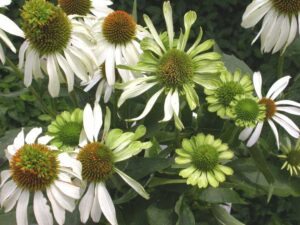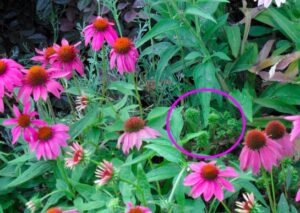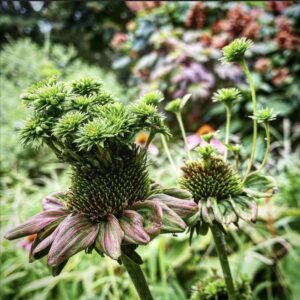When walking by one of your garden beds there are many things to be on the lookout for besides beauty. The images in these pictures documents one of the classic symptoms of “Aster Yellows”. These Purple Coneflowers (above) display some of the most dramatic evidence of this non-fatal, but potentially prolific disease. Secondary flower heads emerging from primary flowers are a common sight. However, Aster Yellows is a disease that affects over 300 species of plants including herbaceous ornamentals, vegetables and even weeds.
Infected plants can serve as the starting place for the spread to other non-infected plants. The source of the problem is a bacteria-like microscopic organism known as a phytoplasma. A tiny insect known as a leafhopper most commonly spreads it. As the leafhopper feeds on infected plants, it is taking in this phytoplasma through the plant sap. Once inside the insect’s body, the disease organisms multiply rapidly. Eventually, the phytoplasma is then reintroduced as the leafhopper feeds on healthy plants.

Symptoms of Aster Yellows develop most quickly and are more severe when temperatures are warm. In cooler temperatures, plants may be infected without any visible indication. Unique symptoms also vary between plant types. Symptoms common to most infected plants include yellow foliage, stunted growth, flowers that remain on the green side, and an overall distorted look.
Controlling Aster Yellows is challenging. There is no known cure for the disease, and chemical control of the vectoring leafhopper is usually not effective and therefore not recommended. The best means of control for this problem, as well as many other garden diseases is good sanitation. Remove and destroy any infected plants you see immediately. This includes all weeds, since they can be a common host source for this disease.

Lastly, not all plants are susceptible to the disease. Most woody shrubs seem to avoid the problem as well as a few herbaceous plants such as salvia, geraniums and impatiens. Choosing resistant plants and removal of infected plants are the best control methods for controlling Aster Yellows in the home landscape. Keep vigilant and when in doubt consult a professional.





